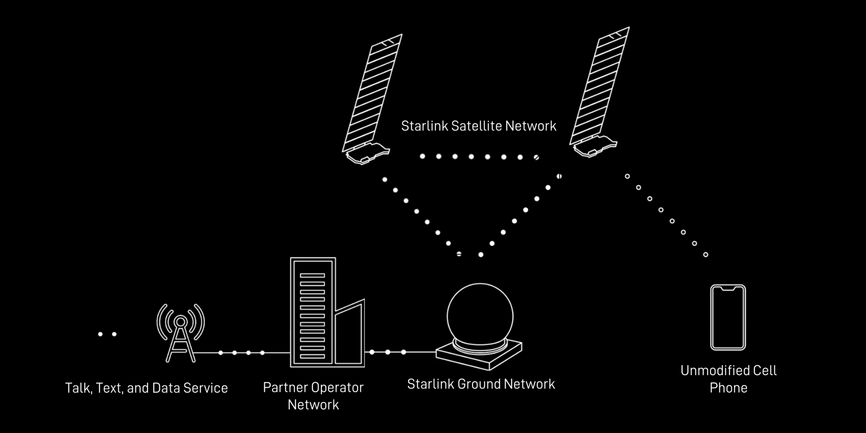Starlink sent and received texts over a 4G/LTE connection between mobile phones via its latest generation of satellites, called v2mini, for the first time this month, following similar projects from Amazon, Apple, AST SpaceMobile, Huawei, and Lynk Global. Starlink—the satellite constellation operated by SpaceX—will offer text messaging to subscribers of at least eight different mobile-network operators around the world and may offer voice and data coverage without the need for the ground terminals its customers now use in “coming years,” Starlink’s U.S. partner T-Mobile said in a statement.
Starlink は、Amazon、Apple、AST SpaceMobile、Huawei、Lynk Global の同様のプロジェクトに続き、v2mini と呼ばれる最新世代の衛星を介した携帯電話間の 4G/LTE 接続を介して、今月初めてテキストを送受信しました。 SpaceX が運営する衛星群である Starlink は、世界中の少なくとも 8 つの異なるモバイル ネットワーク オペレーターの加入者にテキスト メッセージングを提供し、「今後数年以内に、顧客が現在使用している地上端末を必要とせずに音声およびデータ通信範囲を提供する可能性があります。」 」とStarlinkの米国パートナーであるT-Mobileは声明で述べた。
The Starlink achievement is the latest example of how satellites and cellular base stations are converging. A handful of companies are exploiting cheaper satellite fabrication and launch costs, as well as adapting existing technologies such as beamforming, to bridge the several hundred kilometers between mobile phones and orbiting satellites. Among the many new wrinkles those companies have to iron out is the fact that for the first time, the towers themselves are the mobile component of the network: Low Earth orbit (LEO) satellites move at tens of thousands of kilometers an hour, so they have little time to communicate with any one mobile phone on the Earth’s surface.
Starlink の成果は、衛星と携帯基地局がどのように統合されているかを示す最新の例です。少数の企業が、より安価な衛星製造および打ち上げコストを活用し、またビームフォーミングなどの既存技術を適応させて、携帯電話と周回衛星との間の数百キロメートルの距離を橋渡ししています。これらの企業が解決しなければならない新たな問題の多くは、タワー自体が初めてネットワークの可動コンポーネントになっているという事実です。地球低軌道 (LEO) 衛星は時速数万キロメートルで移動するため、地球上の携帯電話で通信する時間はほとんどありません。
The companies competing to solve these problems have so far sent and received text messages on conventional phones via a commercial satellite (Huawei/China Telecom; Lynk Global; Apple/Globalstar) and performed voice and data calls over 5G via an experimental satellite (AST SpaceMobile) as IEEE Spectrumhas reported. Investors have taken notice: Lynk Global is going public in a deal that values the company at up to US $800 million while AT&T, Google, and Vodafone recently invested in AST SpaceMobile, which has a market capitalization of $674.6 million.
これらの問題を解決しようと競合している企業は、これまでのところ、商用衛星(ファーウェイ/チャイナテレコム、Lynk Global、Apple/Globalstar)を介して従来の電話機でテキストメッセージを送受信し、実験衛星(AST SpaceMobile)を介して5Gを介して音声通話とデータ通話を実行しています。 )IEEE Spectrumが報告したように。投資家は注目しています。Lynk Global は、同社の評価額を最大 8 億米ドルとする取引で株式を公開する予定ですが、AT&T、Google、Vodafone は最近、時価総額 6 億 7,460 万ドルの AST SpaceMobile に投資しました。
“I recall many discussions 10 years ago where the mobile operators told the satellite people, ‘Your price points are way too high.’ This has totally changed due to more availability of the technology, more agile development, and a different approach to failure.”—ANDREAS KNOPP, UNIVERSITY OF THE BUNDESWEHR
「10年前、移動体通信事業者が衛星関係者に『価格が高すぎる』と言っていた多くの議論を思い出します。テクノロジーの可用性の向上、より機敏な開発、そして障害に対する異なるアプローチにより、この状況は完全に変わりました。 」—アンドレアス・クノップ、ドイツ連邦大学
Until very recently, satellites could not connect to mobile phones hundreds of kilometers below. The sort of satellite phones people took on expeditions to more remote places have chunky antennas, require clear lines of sight to multiple satellites, and take a while to acquire a signal. Integrating terrestrial and satellite cellular networks isn’t as easy as moving between cell towers and handing off the signal from one to the next.
つい最近まで、衛星は数百キロメートル下で携帯電話に接続できませんでした。人々がより遠隔地への遠征に使用した種類の衛星電話には分厚いアンテナが付いており、複数の衛星までの見通しの良い見通し線が必要で、信号を取得するのに時間がかかります。地上携帯電話ネットワークと衛星携帯電話ネットワークの統合は、携帯電話の基地局間を移動して信号を次の基地局に受け渡すほど簡単ではありません。
Indeed, the task is so difficult that one research group built an experimental application to help an Internet-connected livestock truck equipped with its own computer switch to an onboard Starlink ground station when the truck loses the cellular network signal. Achieving a seamless integration of terrestrial and nonterrestrial networks is the ultimate goal, says study coauthor Melisa López, a wireless communications researcher at the University of Aalborg in Denmark.
実際、この作業は非常に難しいため、ある研究グループは、専用のコンピュータを搭載したインターネットに接続された家畜トラックが携帯電話ネットワーク信号を失ったときに車載のスターリンク地上局に切り替えるのを支援する実験的アプリケーションを構築しました。地上ネットワークと非地上ネットワークのシームレスな統合を達成することが最終的な目標であると、研究共著者でデンマークのオールボー大学の無線通信研究者であるメリサ・ロペス氏は述べています。
Starlink doesn’t explain many details of its 4G connection, but existing commercial constellations reveal several of the building blocks of seamless satellite cellular connections, and researchers have published at least one promising lead for future constellations.
Starlink は 4G 接続の詳細については多くを説明していませんが、既存の商用コンステレーションはシームレスな衛星セルラー接続の構成要素のいくつかを明らかにしており、研究者らは将来のコンステレーションに向けた有望な手がかりを少なくとも 1 つ発表しています。
Three Keys to Connecting Phones to Satellites
Instead of redesigning mobile phones to be more like satellite phones, companies are redesigning the satellite network to meet mobile phones more than halfway. They are making the antennas on the satellites much bigger in their scramble to turn satellites into cellphone towers. For example, AST SpaceMobile’s first satellites had antennas with surface areas of 64 square meters, followed by second generation satellites with 128 m2 antennas, with plans for going up to 400 m2. Starlink’s new v2mini satellite antennas are 6.21 m2, but Starlink plans even larger cellular-compatible satellites that it will launch when its larger Starship rocket is available.
電話を衛星に接続するための 3 つの鍵 企業は、携帯電話を衛星電話に近づけるために再設計するのではなく、携帯電話に半分以上適合するように衛星ネットワークを再設計しています。彼らは衛星を携帯電話の塔に変えようと、衛星のアンテナを大幅に大型化しています。たとえば、AST SpaceMobile の最初の衛星には表面積が 64 平方メートルのアンテナがあり、その後、第 2 世代の衛星には 128 平方メートルのアンテナが搭載され、最大 400 平方メートルになる予定です。 Starlink の新しい v2mini 衛星アンテナは 6.21 平方メートルですが、Starlink はさらに大型のセルラー互換衛星を計画しており、大型の Starship ロケットが利用可能になったら打ち上げる予定です。
Companies are also making their satellites more like cellphone towers by flying them lower than before. For the first few decades of the space age, communications satellites were inserted into geosynchronous orbits much higher above the Earth, where they could cover a large portion of the planet’s surface for a relatively long period of time. However, those satellites handled far fewer devices than exist today.
企業はまた、衛星を以前よりも低く飛行させて、携帯電話の塔に似せようとしている。宇宙時代の最初の数十年間、通信衛星は地球よりはるかに高い静止軌道に投入され、比較的長期間にわたって惑星の表面の大部分をカバーすることができました。ただし、それらの衛星が処理するデバイスは、今日存在するものよりはるかに少数でした。
The advent of smaller and cheaper satellites and cheaper launch costs in the last decade or so have enabled business models that rely on many cheaper satellites flown in low Earth orbit. These new satellites won’t last as long but will be better able to detect the weak signals from mobile phones on the surface and handle their growing traffic.
過去 10 年ほどで小型で安価な衛星が出現し、打ち上げコストが安くなったことで、地球低軌道で飛行する安価な衛星を多数利用するビジネス モデルが可能になりました。これらの新しい衛星はそれほど長くは続かないものの、地上の携帯電話からの弱い信号をよりよく検出し、増大するトラフィックを処理できるようになります。

SpaceX’s Starlink network can connect directly to an off-the-shelf cellphone, potentially eliminating the need for bulky satellite phones.STARLINK
SpaceX の Starlink ネットワークは、既製の携帯電話に直接接続できるため、かさばる衛星電話が不要になる可能性があります。STARLINK
“I recall many discussions 10 years ago where the mobile operators told the satellite people, ‘Your price points are way too high.’ This has totally changed due to more availability of the technology, more agile development, and a different approach to failure,” says Andreas Knopp, a signal processing engineer at the University of the Bundeswehr in Munich.
「10年前、移動体通信事業者が衛星関係者に『価格が高すぎる』と言っていた多くの議論を思い出します。技術の可用性の向上、開発の機敏性の向上、障害に対するアプローチの違いにより、この状況は完全に変わりました。 」とミュンヘンドイツ連邦大学の信号処理エンジニアであるアンドレアス・クノップ氏は言います。
Another contributor is improved beamforming, which is how a transmitting device calculates the best way to direct its signal to reach a particular recipient, without interfering with other recipients. That may involve bouncing a signal off a building or mountainside, from terrestrial towers, or it may involve precise targeting of a narrow, fast-moving signal, from a satellite moving tens of thousands of kilometers per hour.
もう 1 つの貢献は、ビームフォーミングの改善です。これは、送信デバイスが、他の受信者に干渉することなく、信号を特定の受信者に到達させるための最適な方法を計算する方法です。これには、建物や山腹、地上の塔から信号を反射することが含まれる場合もあれば、時速数万キロメートルで移動する衛星からの狭く高速で移動する信号を正確にターゲットすることが含まれる場合もあります。
More sophisticated beamforming can involve sending the same signals from multiple antennas so that the signal’s reinforce each other, a bit like when sound waves harmonize. Anyone who has tuned a home speaker system to provide the best sound at the point of a particular couch has done beamforming, probably with the help of sophisticated software in the background.
より高度なビームフォーミングでは、複数のアンテナから同じ信号を送信して、音波が調和するときのように、信号が相互に強化されるようにすることができます。特定のソファの位置で最高のサウンドを提供するようにホーム スピーカー システムを調整した人は誰でも、おそらくバックグラウンドで高度なソフトウェアの助けを借りて、ビームフォーミングを行ったことがあるでしょう。
In the future, it may be worth spreading the task of beamforming across even more satellites than now, write the authors of a pair of recent papers. A scenario floated in one of the studies is the use of more than two dozen tiny satellites flying in close formation to replicate the work done today by one cellular-compatible satellite. “Each of these satellites is now independent, with its own components. The main aspect is this synchronization algorithm, which has to align frequency, phase, and the time for the signals to arrive coherently,” says Diego Tuzi, a graduate student studying signal processing at the University of the Bundeswehr who, together with Knopp, is a coauthor on one of those recent papers.
将来的には、現在よりもさらに多くの衛星にビームフォーミングのタスクを分散させる価値があるかもしれない、と最近の 2 つの論文の著者は書いています。研究の 1 つで浮上したシナリオは、1 台のセルラー互換衛星によって今日行われている作業を再現するために、密集編隊を組んで飛行する 20 機以上の小型衛星を使用するというものです。 「これらの衛星はそれぞれ独立しており、独自のコンポーネントを備えています。主な側面はこの同期アルゴリズムであり、信号が一貫して到着するまでの周波数、位相、時間を調整する必要があります」とドイツ連邦軍大学で信号処理を研究している大学院生で、クノップ氏とともにディエゴ・トゥジ氏は述べています。最近の論文の 1 つの共著者です。
For now, what Starlink and its competitors are offering is very little, though it is a necessary step. “It’s better than nothing,” says Thomas Delamotte, another coauthor on the recent paper and a signal processing engineer at the University of the Bundeswehr, “but if you want to have a long-term perspective we will need new approaches to make 6G ubiquitous.”
今のところ、Starlink とその競合他社が提供しているものはごくわずかですが、それは必要なステップではあります。 「何もしないよりはマシです」と、最近の論文のもう一人の共著者でドイツ連邦国防大学の信号処理エンジニアであるトーマス・デラモット氏は言います。 」


 Thecryptoupdates
Thecryptoupdates DogeHome
DogeHome The Crypto Times
The Crypto Times Coincu
Coincu Optimisus
Optimisus Coin_Gabbar
Coin_Gabbar Optimisus
Optimisus






















